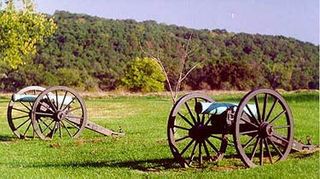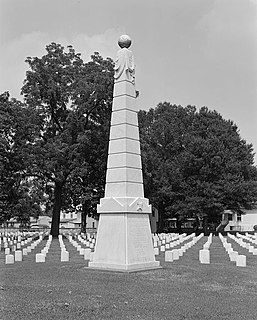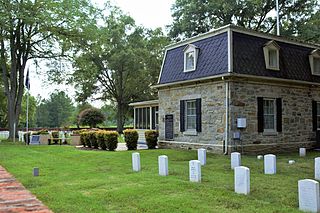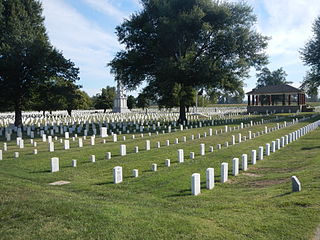
Fort Pillow State Historic Park is a state park in western Tennessee that preserves the American Civil War site of the Battle of Fort Pillow. The 1,642 acre (6.6 km²) Fort Pillow, located in Lauderdale County on the Chickasaw Bluffs overlooking the Mississippi River, is rich in both historic and archaeological significance. In 1861, the Confederate army built extensive fortifications and named the site for General Gideon Johnson Pillow of Maury County. It was attacked and held by the Union Army for most of the American Civil War period except immediately after the Battle of Fort Pillow, when it was retaken by the Confederate Army. Many African-American soldiers were killed in what modern historians describe as a "massacre" or "atrocity". Interpretive sites are part of the park.

USS Cairo was one of the first American ironclad warships built at the beginning of the U.S. Civil War.

Wilson's Creek National Battlefield at 6424 West Farm Road 182 near Republic, Missouri, preserves the site of the Battle of Wilson's Creek. Fought on August 10, 1861, it was the first major American Civil War engagement west of the Mississippi River. The Confederate's failure to exploit their victory here resulted in keeping Missouri in the Union. Major features include a 5-mile automobile tour loop, the restored 1852 Ray House, and "Bloody Hill," the scene of the major battle. The site is located just southwest of the city of Springfield, in southwestern Missouri.

This is a list of properties and districts in Illinois that are on the National Register of Historic Places. There are over 1,800 in total. Of these, 85 are National Historic Landmarks. There are listings in all of the state's 102 counties.

Alexandria National Cemetery is a United States National Cemetery, of approximately 5.5 acres (2.2 ha), located in the city of Alexandria, Virginia. Administered by the United States Department of Veterans Affairs, it is one of the original national cemeteries that were established in 1862. As of 2014, it was site to over 4,500 interments. The cemetery can accommodate the cremated remains of eligible individuals.

City Point National Cemetery is a United States National Cemetery in the community of City Point within the city of Hopewell, Virginia. Administered by the United States Department of Veterans Affairs, it encompasses 6.7 acres (2.7 ha), and as of the end of 2005, had 6,909 interments. It is managed by Hampton National Cemetery.

Crown Hill National Cemetery is a U.S. National Cemetery located in Indianapolis, Marion County, Indiana. It was established in 1866 on Section 10 at Crown Hill Cemetery, a privately owned cemetery on the city's northwest side. Administered by the United States Department of Veterans Affairs, the National Cemetery encompasses 1.4 acres (0.57 ha) and serves as a burial site for Union soldiers who fought in the American Civil War.

Fort Harrison National Cemetery is a United States National Cemetery located seven miles (11 km) south of the city of Richmond, in Henrico County, Virginia. Administered by the United States Department of Veterans Affairs, It encompasses 1.5 acres (0.61 ha), and as of the end of 2005, had 1,570 interments.

Loudon Park National Cemetery is a United States National Cemetery located in the city of Baltimore, Maryland. Administered by the United States Department of Veterans Affairs, it encompasses 5.2 acres (2.1 ha), and as of the end of 2005, had 7,138 interments. It is currently closed to new interments, and is maintained by the Baltimore National Cemetery.

Mound City National Cemetery is a United States National Cemetery located near Mound City, in Pulaski County, Illinois. It encompasses 10.5 acres (4.2 ha), and as of the end of 2005, had 8,098 interments. Administered by the United States Department of Veterans Affairs, it is managed by the Jefferson Barracks National Cemetery. This cemetery is listed on the National Register of Historic Places.

Danville National Cemetery is a United States National Cemetery located in the city of Danville, Virginia. Administered by the United States Department of Veterans Affairs, it encompasses 3.5 acres (1.4 ha) and, as of the end of 2005, it had 2,282 interments. It is managed by Salisbury National Cemetery.

The United States Marine Hospital in Louisville, Kentucky, in the Portland neighborhood was built in 1845, and is considered by the National Park Service to be the best remaining antebellum hospital in the United States. Of the seven hospitals built in the mid-19th century by the Marine Hospital Service "for the benefit of sick seamen, boatmen, and other navigators on the western rivers and lakes." It is the only one still standing, even after surviving two tornadoes. The building has been extensively restored to match its appearance in 1899.

The Grand Army of the Republic Hall is an historic building located at 23 East Downer Place on Stolp Island in Aurora, Illinois, in the United States.

The Union Monument in Louisville is located in Cave Hill Cemetery in Louisville, Kentucky. It was built in 1914 from granite, honoring unknown soldiers who fought in the Union during the American Civil War. It is in front of the large number of Union soldiers buried at Cave Hill.

The United States Marine Hospital, formerly known as Frank S. Keeler Memorial Hospital, is a historic Greek Revival hospital building in Mobile, Alabama, United States. Construction began in 1838 and was completed in 1842. It was designed by architect Frederick Bunnell and was operated by the Marine Hospital Service from its opening until it closed, in 1952. It treated injured Confederate and Union soldiers during the American Civil War. It shares some design features, such as its two-story colonnades, with its neighbor, the old Mobile City Hospital.

The Battle of Tebb's Bend Monument in Taylor County, Kentucky, near Campbellsville, Kentucky, commemorates the Battle of Tebbs Bend, which occurred on July 4, 1863 during the Civil War. The battle was essentially a Union victory, as it greatly delayed John Hunt Morgan's famous Raid that would later go into Indiana and Ohio.

The Eastern Promenade is a historic promenade, 68.2-acre (27.6 ha) public park and recreation area in Portland, Maine. Construction of the Promenade began in 1836 and continued periodically until 1934. The 1.5-mile (2.4 km) park was designed by the Olmsted Brothers design firm and experienced its greatest expansion from the 1880s to the 1910s. The Promenade rings around the Munjoy Hill neighborhood and occupies the farthest eastern portion of Portland's peninsula. The Promenade is home to many historical sites, including a mass grave and the mast of USS Portland.

Camp Mather-Camp Logan is a Civil War campsite located along Illinois Route 13 outside of Shawneetown, Illinois. The campsite was Henry and Mary Eddy's farm and summer home; Henry died in 1849, leaving Mary in charge of the farm at the outset of the war. The Union Army began camping on the property in December 1861, when the 56th Illinois Infantry occupied the land; the camp was named Camp Mather for Illinois adjutant general Thomas S. Mather. The camp, part of the Department of the Ohio, was one of two Union campsites near Shawneetown, the other being Camp Katie Yates. The farm's summer home became the camp hospital and was used to treat measles patients during an outbreak in the winter of 1861-62 that killed eight soldiers. By the fall of 1862, when the 87th Illinois Infantry occupied the camp, the camp was known as Camp Logan. The soldiers of the 87th Infantry went without pay for several months while awaiting assignment and transport at the camp, and two companies nearly mutinied due to the situation. The 87th Infantry left the camp for Memphis, Tennessee, in March 1863, marking the end of Union occupation of the site.

The Alton Military Prison was a prison located in Alton, Illinois and originally built in 1833 as the first state penitentiary in Illinois and later closed in 1857. During the American Civil War, the prison was reopened in 1862 to accommodate the growing population of Confederate prisoners of war and ceased to be prison at the end of the war in 1865. The prison building was demolished not long after the Civil War. All that remains of the former prison site is a section of ruin wall that is maintained by the State of Illinois as an historic site. The prison site is included in the U.S. National Register of Historic Places.

The St. Charles Battle Monument is located at the center of the intersection of Broadway and Arkansas Street in the center of St. Charles, Arkansas. It commemorates the 1862 Battle of Saint Charles, a naval and land engagement of the American Civil War that took place just downriver from the city. It is a square granite monument, topped by an inverted cannon barrel. It is 18 feet (5.5 m) high and 9.5 feet (2.9 m) square. Its inscriptions commemorate the 148 Union soldiers who died in the explosion of the USS Mound City, caused by what is sometimes described as the single deadliest shot fired in the entire Civil War. Inscriptions on another side memorialize the smaller number of Confederate dead in the engagement. The monument was placed in 1919 through the efforts of a relative of William Hickman Harte, the master on board the Mound City who died in the explosion, and is one of the few memorials placed in a Confederate state by a northerner in commemoration of both Union and Confederate war dead.





























